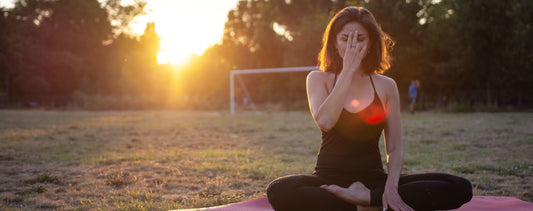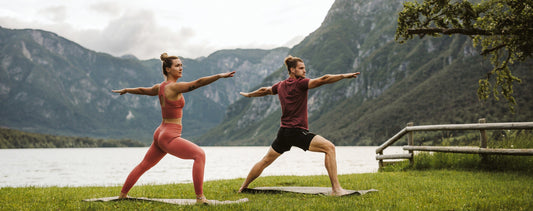In the midst of life happening all around us, sometimes it can feel easy to forget the practices that nurture our hearts. We get caught up in the day-to-day tasks, the demands of all of the happenings in our lives and it seems like the practices for ourselves are the first ones to slip away.
The practice of nurturing your heart is an everyday exploration, a commitment to show up for yourself in all the ways that serve you best, knowing that each day it may look slightly different. With that awareness, we can explore various practices that adapt to what we need most in each phase of our evolution.
In Part 1 of Asana Practices to Nurture Your Heart, we’ll explore various asanas that can bring in the qualities of self-compassion and self-nurturing.
Some of the best practices begin with self-compassion, self-nurturing, self-gratitude, and self-love.
On the Chopra App, you can discover a new series that guides you through various meditations centered around these specific themes.
When our practices are rooted in these qualities we begin to bring all of our love and care back into our own hearts.
When you’re seeking self-compassion in your world, invite some of these shapes into your asana practice. Remember to always find the most supportive and easeful way of being for your particular practice.
Child's Pose
Begin in a tabletop position, with your shoulders stacking somewhere over your wrists and knees under the hips. Connect your big toes at the back of your space and gently settle your sitting bones in the direction of your heels. If it feels comfortable, you might place a pillow or a blanket between the calves and the seat. As the hips move back in space, begin to walk your hands forward. You are welcome to stay here or invite the palms to connect in a prayer position out in front of you. From here, bend your elbows and allow the prayer position to move towards the base of your skull. Stay here for 10 or more breaths, breathe into compassion and out with the same intention. Allow yourself to ground here and settle for as long as you need.
Lizard Shape
Make your way from the child’s pose back into your tabletop position. As you’re ready, extend one leg behind you. From here begin to step that foot towards the outside of your hand on the same side to make your way into a wide lunge or lizard lunge. You might invite a blanket under your back knee for comfort and added support.
With both hands on the mat inside your front leg, take a moment to pause and notice any sensations in your body. Is the body asking for anything? You might offer yourself blocks or pillows under your hands to add support and raise the ground towards you. If it feels comfortable and spacious in your body, explore bringing your forearms to the earth or the props. Take about 5 to 10 full breaths here and notice where you can extend a little extra compassion for yourself as you clear away any stuck energies from within the body. When you are ready, switch sides.
Seated Forward Fold
From your lizard lunge, find your way back into a tabletop position. Shift your heels to one side and have a seat behind your heels as you extend your legs out in front of you. If there is any tension in the low back or you’d simply like to be supported, place a blanket or pillow under your seat. Take a moment to breathe here and notice any sensation in the body. When you are ready, as you inhale bring your arms over your ears. As you exhale begin to fold forward. Let your hands land wherever it feels most comfortable, that might be on the toes, the shins, the thighs, or on the ground framing the legs. Be gentle with yourself as you settle into this shape for a few minutes.
When you’re looking to invite the practice of self-nurturing in, try adding these shapes to your asana practice. Knowing that as you create any shapes on your mat, you can give yourself full permission to take the shape and the variation that nurtures you best today.
Reclined Pigeon Shape
Begin this practice lying down comfortably on your mat, towel, carpet, or any surface that provides support. Bend your legs at the knees and ground your feet into the mat. Extend your right leg into the sky at any capacity. As you are ready, bend your right leg gently and cross your ankle over the left knee, creating a figure four shape with the legs.
You are welcome to stay right here, guiding your right knee away from your torso and feeling the connection point on the surface beneath your grounding you further. If you’d like, you can explore connecting your hand to the back of your left hamstring. As you draw the left knee closer to your heart keep gently guiding the right knee away. Remain here for as long as feels good and when you are ready, switch sides.
Reclined Bound Angle
When you’ve finished both sides in your reclined pigeon shape, reground both feet into your mat. Begin to walk your feet towards one another until the soles of your feet meet. As the feet connect, let your knees drop to either side, making your way into a reclined bound angle. If the knees are craving support or more connection to a foundation, slide blocks, blankets, or pillows under each knee. Allow your hands to rest wherever it feels best, either beside the body, on the torso in some capacity, or connected to the hips or legs. Take a few full, deep breaths here to settle and connect to this present space, giving yourself time to tune in and nurture your heart. Remain in this shape for 3-5 minutes if that feels easeful and comforting.
Bridge Pose
Begin to draw your knees back towards one another so that the knees point skyward and the feet reground into the mat. If you have a block, a pillow, or a rolled-up blanket bring it within reach as we set up for this next shape.
From the reclined position with the feet resting on the mat, begin to press into your feet and let your hips gently float away from the ground. As the hips rise, locate your prop and place it at the low back, underneath your sacrum. If you don’t have a prop nearby simply let your hips float here, resist the desire to press the hips towards the sky with any intensity. If your back body is supported by a prop, rest into the prop and allow this prop to nurture you with support. Stay in this shape for as long as feels good.
Self-compassion and self-nurturing are two of many themes you can explore that may support your practice in holding space for yourself. As you bring compassion into your practice, you might find that you’re holding more space for the wholeness of yourself. Maybe taking on a more forgiving, gentle, or tender practice as you move through your days. With the intention to nurture yourself in every moment, you might notice the thoughts, feelings, and emotions becoming less overwhelming. Each new day is another opportunity to nurture ourselves in any way that serves us best.
As you follow along with the meditation series on the Chopra App, invite these asanas in with the days you meditate with these themes.
In Part 2 of Asanas to Nurture Your Heart, we explore asanas focused on bringing self-gratitude and self-love into your practice.
Cultivate self-compassion and self-love with Nurture Your Heart, a four-part program with Daniel Sannito, available now in the Chopra App.
The practice of nurturing your heart is an everyday exploration, a commitment to show up for yourself in all the ways that serve you best, knowing that each day it may look slightly different. With that awareness, we can explore various practices that adapt to what we need most in each phase of our evolution.
In Part 1 of Asana Practices to Nurture Your Heart, we’ll explore various asanas that can bring in the qualities of self-compassion and self-nurturing.
Some of the best practices begin with self-compassion, self-nurturing, self-gratitude, and self-love.
On the Chopra App, you can discover a new series that guides you through various meditations centered around these specific themes.
When our practices are rooted in these qualities we begin to bring all of our love and care back into our own hearts.
Asana for Self-Compassion
When you’re seeking self-compassion in your world, invite some of these shapes into your asana practice. Remember to always find the most supportive and easeful way of being for your particular practice.
Balasana with Reverse Prayer Hands
Child's Pose
Begin in a tabletop position, with your shoulders stacking somewhere over your wrists and knees under the hips. Connect your big toes at the back of your space and gently settle your sitting bones in the direction of your heels. If it feels comfortable, you might place a pillow or a blanket between the calves and the seat. As the hips move back in space, begin to walk your hands forward. You are welcome to stay here or invite the palms to connect in a prayer position out in front of you. From here, bend your elbows and allow the prayer position to move towards the base of your skull. Stay here for 10 or more breaths, breathe into compassion and out with the same intention. Allow yourself to ground here and settle for as long as you need.
Utthan Pristhasana
Lizard Shape
Make your way from the child’s pose back into your tabletop position. As you’re ready, extend one leg behind you. From here begin to step that foot towards the outside of your hand on the same side to make your way into a wide lunge or lizard lunge. You might invite a blanket under your back knee for comfort and added support.
With both hands on the mat inside your front leg, take a moment to pause and notice any sensations in your body. Is the body asking for anything? You might offer yourself blocks or pillows under your hands to add support and raise the ground towards you. If it feels comfortable and spacious in your body, explore bringing your forearms to the earth or the props. Take about 5 to 10 full breaths here and notice where you can extend a little extra compassion for yourself as you clear away any stuck energies from within the body. When you are ready, switch sides.
Paschimottanasana
Seated Forward Fold
From your lizard lunge, find your way back into a tabletop position. Shift your heels to one side and have a seat behind your heels as you extend your legs out in front of you. If there is any tension in the low back or you’d simply like to be supported, place a blanket or pillow under your seat. Take a moment to breathe here and notice any sensation in the body. When you are ready, as you inhale bring your arms over your ears. As you exhale begin to fold forward. Let your hands land wherever it feels most comfortable, that might be on the toes, the shins, the thighs, or on the ground framing the legs. Be gentle with yourself as you settle into this shape for a few minutes.
Asana for Self-Nurturing
When you’re looking to invite the practice of self-nurturing in, try adding these shapes to your asana practice. Knowing that as you create any shapes on your mat, you can give yourself full permission to take the shape and the variation that nurtures you best today.
Supta Kapotasana
Reclined Pigeon Shape
Begin this practice lying down comfortably on your mat, towel, carpet, or any surface that provides support. Bend your legs at the knees and ground your feet into the mat. Extend your right leg into the sky at any capacity. As you are ready, bend your right leg gently and cross your ankle over the left knee, creating a figure four shape with the legs.
You are welcome to stay right here, guiding your right knee away from your torso and feeling the connection point on the surface beneath your grounding you further. If you’d like, you can explore connecting your hand to the back of your left hamstring. As you draw the left knee closer to your heart keep gently guiding the right knee away. Remain here for as long as feels good and when you are ready, switch sides.
Supta Baddha Konasana
Reclined Bound Angle
When you’ve finished both sides in your reclined pigeon shape, reground both feet into your mat. Begin to walk your feet towards one another until the soles of your feet meet. As the feet connect, let your knees drop to either side, making your way into a reclined bound angle. If the knees are craving support or more connection to a foundation, slide blocks, blankets, or pillows under each knee. Allow your hands to rest wherever it feels best, either beside the body, on the torso in some capacity, or connected to the hips or legs. Take a few full, deep breaths here to settle and connect to this present space, giving yourself time to tune in and nurture your heart. Remain in this shape for 3-5 minutes if that feels easeful and comforting.
Setu Bandha Sarvangasana
Bridge Pose
Begin to draw your knees back towards one another so that the knees point skyward and the feet reground into the mat. If you have a block, a pillow, or a rolled-up blanket bring it within reach as we set up for this next shape.
From the reclined position with the feet resting on the mat, begin to press into your feet and let your hips gently float away from the ground. As the hips rise, locate your prop and place it at the low back, underneath your sacrum. If you don’t have a prop nearby simply let your hips float here, resist the desire to press the hips towards the sky with any intensity. If your back body is supported by a prop, rest into the prop and allow this prop to nurture you with support. Stay in this shape for as long as feels good.
Self-compassion and self-nurturing are two of many themes you can explore that may support your practice in holding space for yourself. As you bring compassion into your practice, you might find that you’re holding more space for the wholeness of yourself. Maybe taking on a more forgiving, gentle, or tender practice as you move through your days. With the intention to nurture yourself in every moment, you might notice the thoughts, feelings, and emotions becoming less overwhelming. Each new day is another opportunity to nurture ourselves in any way that serves us best.
As you follow along with the meditation series on the Chopra App, invite these asanas in with the days you meditate with these themes.
In Part 2 of Asanas to Nurture Your Heart, we explore asanas focused on bringing self-gratitude and self-love into your practice.
Cultivate self-compassion and self-love with Nurture Your Heart, a four-part program with Daniel Sannito, available now in the Chopra App.






















